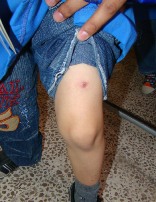 Active case search is a key component to control anthroponotic cutaneous leishmaniasisAnthroponotic cutaneous leishmaniasis is concentrated in the northwest of the Syrian Arab Republic, particularly Aleppo and its surroundings. The parasite is L. tropica and the vector Ph. sergenti. Following a reduction in the number of cases in the 1950s, possibly as a side-effect of antimalarial DDT spraying activities, a resurgence of about 5000 recorded cases occurred in 1988. Since then numbers have risen steadily over the years despite focal indoor spraying with residual insecticides and other control measures. The disease continues to spread to new areas.
Active case search is a key component to control anthroponotic cutaneous leishmaniasisAnthroponotic cutaneous leishmaniasis is concentrated in the northwest of the Syrian Arab Republic, particularly Aleppo and its surroundings. The parasite is L. tropica and the vector Ph. sergenti. Following a reduction in the number of cases in the 1950s, possibly as a side-effect of antimalarial DDT spraying activities, a resurgence of about 5000 recorded cases occurred in 1988. Since then numbers have risen steadily over the years despite focal indoor spraying with residual insecticides and other control measures. The disease continues to spread to new areas.
Control measures include early detection and treatment of cases and vector control. Vector control using indoor residual spraying has been the main strategy for many years. Personal protection measures include the use of impregnated bednets.
Zoonotic cutaneous leishmaniasis due to L. major occurs mainly in the north east and in rural Damascus.
Surveillance includes both active and passive case detection. There is a peripheral centre for leishmaniasis control in each province. Diagnosis and treatment services are provided free of charge and reports are compiled on a monthly basis. Pentavalent antimonials are used for treating patients. Most cases are treated by intra-lesional injections, and in a few cases, intramuscular injections are given.
The provision of treatment at government treatment centres has greatly reduced the severity of the disease in most cases, and the number of severe cases. Treatment coverage has grown from an estimated 25% in 1992 to 80% in 2006. Recent studies found Ph. papatasi and Ph. sergenti to be the most abundant sandflies in Aleppo. The former was mainly endophilic while the latter was equally endo- and ectophilic, and was opportunistic in its feeding habits, with a possible preference for humans and cattle. The bionomics of Ph. sergenti may certainly be in relation to the inefficacy of control campaigns based on indoor spraying with residual insecticides that have been implemented to control the epidemics of anthroponotic cutaneous leishmaniasis in the Aleppo governorate.



